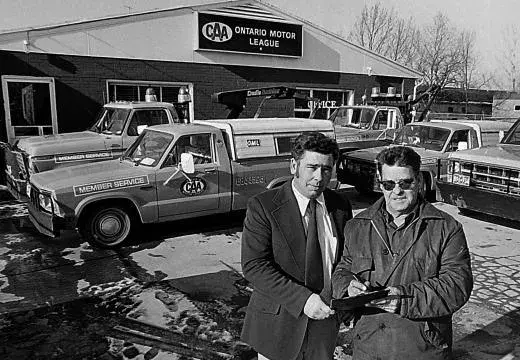
Black Friday Offer! Use promo code BF20 to save 20% off new Memberships. Join now

The Canadian Automobile Association was founded in 1903 by a small but enthusiastic group of motorists eager to advocate for automobile use. Since then, CAA has become a national Member-based lifestyle brand offering exclusive benefits and delivering Canada's most trusted roadside service while advocating for consumers in many areas, including road safety.
We provide the trusted service and peace of mind we want for our lives – that's why every employee is a CAA Member. We build trust through our actions, words and service to others. CAA Membership is about making the most of life's small pleasures and its great, big adventures. We are proudly North & East Ontario and show our authentic passion in everything we do.
1903 – Twenty-seven motorists gather at Queen’s Park to form the Toronto Automobile Club, with Dr. Perry E. Doolittle as the first president. Founding members of Canada’s first advocacy group for motorists take MPPs on a ride to show it was safe to increase the speed limit from 8 mph to 10 mph!
1904 – The first automobile race is held at Exhibition Park.
1906 – The first legislation dealing with motor vehicles is enacted. CAA publishes the first official Road Guide of Canada.
1907 – Toronto, Hamilton, Ottawa and Kingston Auto Clubs operate as the Ontario Motor League (OML) to represent motorists’ interests. OML’s membership includes 170 active and 56 associate Members. OML maintains Motor Vehicle Registrations for Ontario.
1911 – Although auto club members made their own license plates from 1904, the province didn't issue plates until 1911.
1912 – Auto clubs advocate for increased speed limits of 15 mph in urban centres and 20 mph in rural areas.
1913 – OML erects Ontario’s first wooden road signs, under the direction of Dr. Perry Doolittle. By 1937, more than 200,000 road signs are erected on Ontario highways. The Canadian Automobile Federation (now the Canadian Automobile Association) is formed.
1914 – During World War I, OML provides ambulances for the armed forces. Members also pitch in by meeting returning soldiers at train stations and driving them to their homes. Canadian Motorist Magazine is published and issued monthly. The magazine is the forefather of CAA Magazine.
1916 – The Canadian Automobile Federation changes its name to the Canadian Automobile Association (CAA).
1922 – CAA urges the federal government to build the Trans-Canada Highway.
1923 – Emergency Road Service (ERS) is introduced to Members. It includes mechanical service, with tow-ins available for an additional $5 a year.
1927 – A driver’s licence becomes mandatory with OML as one of the issuers. Speed limit increases to 35 mph in rural areas.
1930 – OML’s main advocacy issues include snow removal from highways, luminous warning signs, guard fences, banked turns, road markings, side paths for pedestrians, uniform traffic regulations and glaring headlights.
1937 – CAA launches the School Safety Patrol® program. Ontario student volunteers aged 10 to 13 are trained to keep their peers safe in school zones.
1949 – Parliament passes the Trans-Canada Highway Act.
1961 – OML reorganizes into 11 autonomous auto clubs in Ontario. CAA’s first travel agency, known as World Touring Counselors Limited, opened in Ontario.
1962 – OML advocates for seat belt use in vehicles. As part of its safety campaign, CAA supplies Members with belts that meet Canadian Safety Association standards.
1961 – OML reorganizes into 11 autonomous auto clubs in Ontario. CAA’s first travel agency, known as World Touring Counselors Limited, opened in Ontario.
1962 – OML advocates for seat belt use in vehicles. As part of its safety campaign, CAA supplies Members with belts that meet Canadian Safety Association standards.
1970 – OML is renamed to CAA.
1982 – Ontario Motorist Insurance Company becomes CAA Insurance Company (Ontario).
1998 – The Battery Assist program is introduced, providing Members with on-the-spot battery assessment and replacement.
2002 – CAA and key stakeholders launch the Worst Roads campaign to raise awareness about Ontario’s infrastructure.
2006 – CAA introduces legislation to ban novice drivers from using cell phones and other portable electronic equipment while driving.
2009 – Distracted driving legislation prohibiting the use of handheld devices comes into effect.
2011 – CAA requests that the Ontario provincial government improve safety for roadside assistance workers and motorists through an amendment to the Slow Down, Move Over legislation.
2015 – CAA Insurance Company (Ontario) becomes CAA Insurance Company.
2018 – CAA launches CAA MyPace, Canada's first pay-as-you-go auto insurance.
2020 – CAA Insurance leads the insurance industry with rate reductions and financial relief. In April 2020, CAA Insurance was the first and only insurance company to offer a 10% rate reduction on auto and home insurance policies for the duration of a 12-month policy term.
2021 – CAA launches the CAA Mobile Tire Service and quickly adds additional at-home mobile vehicle services through the CAA Pit Crew.
2022 – CAA North & East Ontario becomes the first club to fully digitize CAA Magazine.
2024 – The Ontario Government replaces a patchwork of bylaws with the Towing and Safety Storage and Enforcement Act (TSSEA) to regulate the towing industry. CAA was instrumental in advocating for changes to protect consumers from opportunistic towing operators.